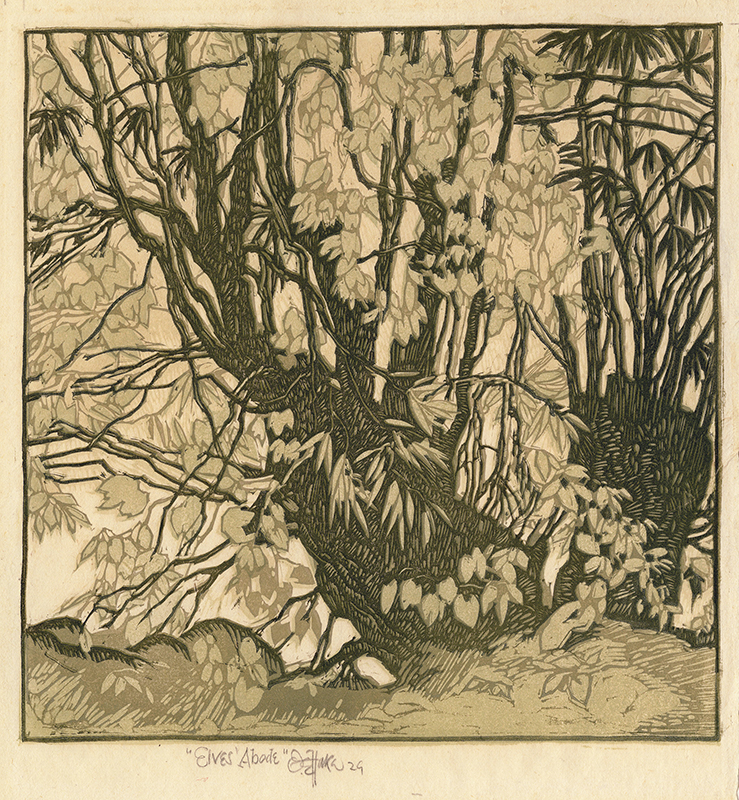Elves’ Abode is a color block print from 1929 by German born American artist Otto Eugene Hake. It is pencil signed, titled, and dated after the signature. Elves’ Abode was printed by the artist on ivory laid Japanese paper and the image measures 9-1/8 x 8-7/8 inches. The edition was not state but is presumed to be quite small.
Hake probably found this copse of trees in Ravine Park in Lake Bluff, Illinois. The park has an attractive system of nature trails that offer a refuge for nature in the densely inhabited suburbs of Chicago. Many artists living in Chicago at the turn of the twentieth century retreated in nature looking for inspiration and restoration after a week of commercial work or other labors that dulled their minds and spirits. In his block print, Hake’s enchantment with the natural beauty of the forested landscape dappled in light is expressed in his chosen title. Certainly in folklore, elves, fairies, and leprechauns lived in kingdoms in forests, meadows, or hollowed-out tree trunks.
Otto Eugene Hake, muralist, printmaker, illustrator, designer, and teacher, was born in Ulm, Germany on December 17, 1876. His family emigrated to the United States in 1890, settling in St. Louis. While still a teenager, Hake apprenticed with a wood engraver in St. Louis and in 1892, at the age of sixteen years, he moved to Chicago to take a job as a wood engraver and illustrator for the printing company Biner-Wells. In 1898, he enlisted in the Spanish American War and when he reached the age of twenty-one, he became a naturalized citizen of the United States. His first formal art training began at the School of the Art Institute of Chicago in 1905, the same year he received his first mural commission for a Chicago public school. In the fall of 1905, Hake was accepted as a member of the Palette & Chisel Club. He is listed as teaching commercial illustration at the School of the Art Institute of Chicago (formerly known as the Chicago Academy of Design) in 1909 and he also worked as a freelance illustrator and designer.
In 1912, Hake traveled to Paris and Munich to study at the Académie Colarossi and the Debschitz Schule, an experimental studio for applied and free art. He returned to Chicago and devoted much of his professional life to the Palette and Chisel Club, teaching classes, steering the club as president, and keeping the club relevant by editing its newsletter, The Cow Bell. Hake was a member of the Palette and Chisel Club from 1905 to at least 1957, and his murals decorate the club’s walls.
He also produced a body of color block prints with landscape subjects in the 1920s and 1930s. They are delicately printed in washes of water-based inks. It is unknown whom he learned the techniques from.
Hake was best known as a muralist, several of which he executed as part of the federal government’s New Deal relief projects sometimes known collectively as the PWA/WPA. He painted two murals in 1936 for the Black Hawk Lodge at the Black Hawk Historic Site, Rock Island, Illinois and at the DuPage Historical Society in Wheaton, Illinois. His other mural projects for public buildings in Chicago and environs, were most notably the Museum of Science and Industry and the Lakeshore Athletic Club. After he completed two school mural projects in 1940, Hake effectively retired from Chicago’s art scene.
He was also a member of and exhibited with the Association of Chicago Painters and Sculptors and the Chicago Gallery Association. His work was included in exhibitions at the Art Institute of Chicago in 1916-1917, 1919-1922, 1924, 1928-1930, and 1933. Hake was included in the 1933 & 1934 World’s Fair exhibition Scenes of a Century of Progress and Painting by Light. His work is in the Palette and Chisel Academy, Chicago; and the National Gallery of Art and the National Portrait Gallery, Washington, D.C.
Otto Eugene Hake died in Chicago, Illinois on 16 July 1965 at the age of eighty-nine.



